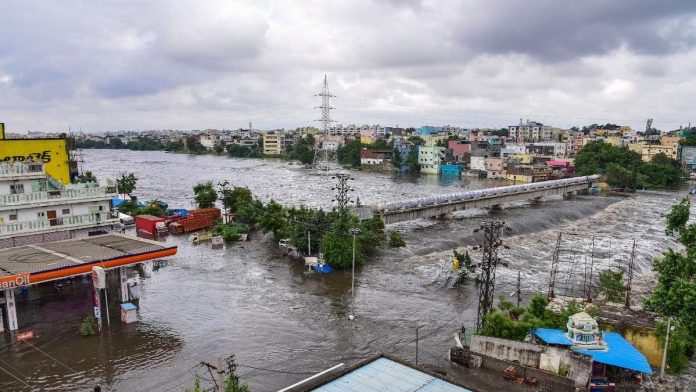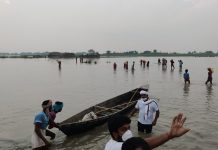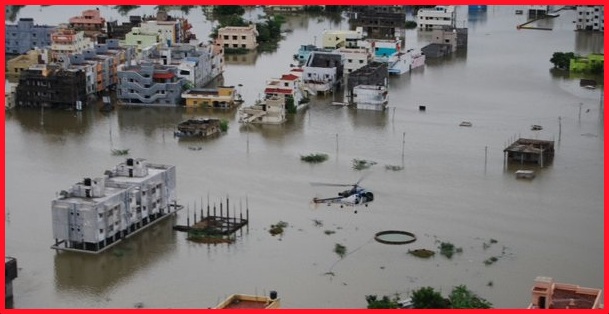Urban flooding is a phenomenon experienced in most cities of India from the onset of monsoon. The flooding is a result of excessive rain water getting trapped within the city boundaries in the absence of sufficient drainage capacity. As a result, life in the affected city comes to a halt with power cuts, roads jammed, houses inundated, accidents and loss of life.
At the moment, Hyderabad is experiencing devastating floods due to the sudden heavy rain triggered by a deep depression in the Bay of Bengal that moved towards Telangana. So far the floods have claimed more than 30 lives in Telangana since October &&. Lives have been lost due to wall collapses, electrocution and people getting washed away in overflowing nalas. Incessant rainfall that started on Wednesday night has enveloped the city of Hyderabad and many other areas in Andhra Pradesh, Telangana and Karnataka. In Hyderabad, the worst affected among all, a two day holiday had been declared for all government offices, private institutions, including banks and financial institutions, across the state for Wednesday and Thursday. As buildings collapsed, trees uprooted, electricity poles came off, vehicles got damaged, thousands of acres of farmland submerged, many dystopian scenes were recorded, making it the first time the city saw such an intense situation after incidence of heavy rainfall. Relief efforts are underway with both the National Disaster Response Force (NDRF) and Army deployed for rescue work.
Meanwhile, parts of Maharashtra is also facing heavy waterlogging as heavy rains lashed Mumbai and Pune and more is predicted to occur in coming days as the weather disturbance in Bay of Bengal that caused heavy rainfall in Telangana, Andhra and Karnataka is likely to move over to the Arabian sea. Mumbai experiences crippling flooding due to rains every year. This year in August, the city saw floods in areas that were never flooded before. Extreme weather events in the city are increasing every year blaring the need for long term planning. Experts have pointed out that apart from alterations in natural cycle, there are man-made factors that have led to Mumbai’s expanding urban flooding. The coastal road project and Metro phase III are being cited as two infrastructure projects that have tampered with the coastal ecology. By reclaiming the sea the coastal road project has caused increased water levels, increased flow speeds and consequently increased bed level changes, claim experts. And the metro project escalated the digging of roads which has altered the underground drainage network as well as claimed open spaces that were playing the role of groundwater retention. Both the projects have been strongly opposed by environmentalists who warned of these consequences.
The problem of flooding in urban areas is therefore not only attributed to climate change variabilities but also majorly to unplanned urbanisation. The flooding of rivers will not be such a catastrophic phenomenon if construction in cities was planned better and in accordance with environmental regulations. What makes urban floods more of a man made disaster is that large scale damage is caused by overburdened drainage, frenzied and unregulated construction, buildings constructed without accounting for natural topography and hydro-geomorphology of the region. Buildings are constructed by encroaching freshwater bodies and wetlands, floodplains and low lands of the city. Usually these spaces act as natural rainwater retention systems, which on becoming cemented and constructed reduce the city’s capacity to absorb rainwater, thereby making the cities dependent only on outflow of surface runoff water.
Heavy concretisation involving construction of impervious surfaces like roads, pavements, buildings and paving over of playgrounds and intertidal regions leads to loss of green cover and open spaces. With the absorbing capacity reduced, there is no other place for the rainwater to run but into the ill-equipped stormwater drains and rivers. Experts have emphasised that extreme weather conditions owing to climate change will become more frequent in future. The need of the hour is to find alternative ways to accommodate stormwater and rainwater. It should be turned into a utility and a resource for the city instead of a burden to get rid of because in a typical urban area, directing more and more surface runoff into drainage will only lead to overload and flooding.
Both private and government mega-projects have been sanctioned for building over vulnerable areas, violating environmental guidelines. In 2000’s, Akshardham Temple Complex and Commonwealth Games Village (CWG) were built right on the Yamuna’s floodplain. Chennai International Airport was built over the Adyar river, constructed on riverine floodplains leading to the 2015 flooding of Chennai. And recently, Andhra Pradesh’s Amaravati had major projects proposed for building over the floodplains of Krishna river.
The communities of people that are the most vulnerable to these disasters are those living in squatter settlements, slums, pavement dwellers, living in suburban and low lying areas that remain waterlogged many days after flooding also. People end up living without services, shelter, potable water, food. These floodwaters with untreated solid waste and faecal matter flow around these squatter settlements and become responsible for outbreaks of diseases such as malaria, dengue, diarrhea etc.
New cities, like Gurugram are now falling victim to poor planning, unregulated construction activity and mismanagement of environmental resources as a result of which the city is losing its water reservoirs and wetlands. Unless sincere measures are taken to withhold and prevent indiscriminate real estate projects and strict abidance to environmental warnings and guidelines are not maintained, Indian cities will continue to face this catastrophic situation every year.














